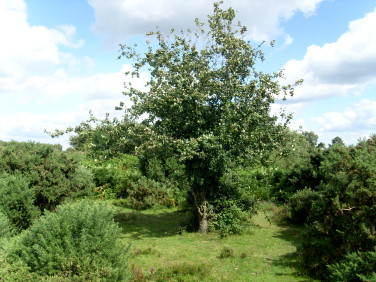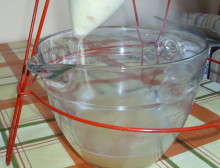Crab Apples
By Mike on Sunday, July 20, 2008, 20:22 - Permalink
We made a trip out to the New Forest we made in hope of finding wild mushrooms or bilberries - we found neither, but found instead Rowan berries and crab apples
What Are Crab Apples?

Malus sylvestris - This plant is the wild ancestor of domestic orchard apples - indeed many of the hedgerow 'crab apple' trees to be found may in fact be the feral offspring of discarded apple cores - apple varieties don't breed true from seed and indeed plant breeders may raise and discard many thousands of seedling plants in order to get one worthwhile variety - so it's perhaps no surprise that feral apples tend to bear small, sour fruit.
 But these are true wild crab apples - the name, by the way, probably has nothing to do with crustaceans, instead deriving from the Norse/Germanic word skrab, which appears to mean 'rough, wiry plant' (and from which we also get the words scrub and shrub).
But these are true wild crab apples - the name, by the way, probably has nothing to do with crustaceans, instead deriving from the Norse/Germanic word skrab, which appears to mean 'rough, wiry plant' (and from which we also get the words scrub and shrub).
Picking Crab Apples
Even in the true wild species, there will be found much variation from one locality to another and even between plants in the same general location - some have plump fruits with pale green skins, others have smaller, rounded ones flushed with red or russet. Some may produce a few apples, others may be positively groaning under the weight of the crop - and some seem more prone to insect damage and rot than others.
So scout around before you fill your basket - if there's one tree, there will be others - and much time is saved in the processing back home if sound, intact apples can be collected.
In The Kitchen
Crab apples have been used as a food for centuries, millennia - so it's not surprising that there are plenty of recipes for using this wild resource.
Cooking
I made several different things with my crab apples - although all of them started the same way - by washing and chopping the apples (no need to peel or core them - just cut out any bad bits), then putting them in a pan with enough water to just cover.
After bringing to the boil and simmering for just a few minutes, the apples quickly cook down - and with the assistance of a potato masher, they're easily reduced to a pulp.
 This pulp goes into the jelly bag to strain off the clear juice.
This pulp goes into the jelly bag to strain off the clear juice.
The solids remaining after straining the clear juice can be passed through a sieve or food mill to produce puree.
The clear juice can be boiled briefly and lightly sweetened for use as cordial, or sweetened at a ratio of 400g sugar to 500ml juice, then boiled until it sets (a sugar thermometer will read 104 C), to produce a beautiful clear amber apple jelly.
Alternatively, the jelly bag stage can be skipped altogether - just strain the cooked pulp straight from the pan, resulting in a pulpy green liquid:
This can be boiled together with sugar (same ratio as for jelly above) to make apple jam - which won't be crystal clear, but will be delicious.
Apple jam or jelly is very versatile - it can be used as a breakfast spread for toast or muffins, but is equally excellent with some strong cheese and crackers, or served with roast meats, especially pork.
More Uses For Crab Apples
Fruit Leather - this is a good way of using up the puree made from the sieved pulp, after the clear juice has been drained off in the jelly bag. The pulp is sweetened with a little sugar (not necessary if made with domestic apples) and spread out to dry.
I used a sheet of baking parchment (which turned out to be less than ideal) - spreading the pulp into a layer about half a centimetre thick. This is best left to dry in a warm place - a sunny windowsill with a slight breeze is great.
After just 24 hours (moving as necessary to follow the sun), the pulp has dried to a rubbery film.
I would have liked to have peeled it off in one piece and cut it into neat shapes, but it stuck rather too well to the parchment - it did come off, but in torn pieces.
The pieces were put on a wire rack and given a further 24 hours in similar conditions - after which they dry to a tough, leathery consistency
The finished product - essentially apple sauce jerky - has good lasting qualities and can be eaten as it is (the aciidity is attenuated by the drying process), or it can be cut into small pieces and mixed into muesli or trail mix.
Crab Apple Cordial - this is made with the clear juice strained through the jelly bag (less than clear here because I was impatient and committed the sin of squeezing the bag) - sweetened with sugar until it's just bearable to taste, but still plenty acidic - the mixture is boiled briefly (any more than a minute, and you'll make jelly), cooled and poured into a bottle.
Stored in the fridge, this will last a couple of weeks - diluted one part to about eight parts water - or more - it makes a delicious refreshing drink, perfect for hot, sticky summer evenings.
